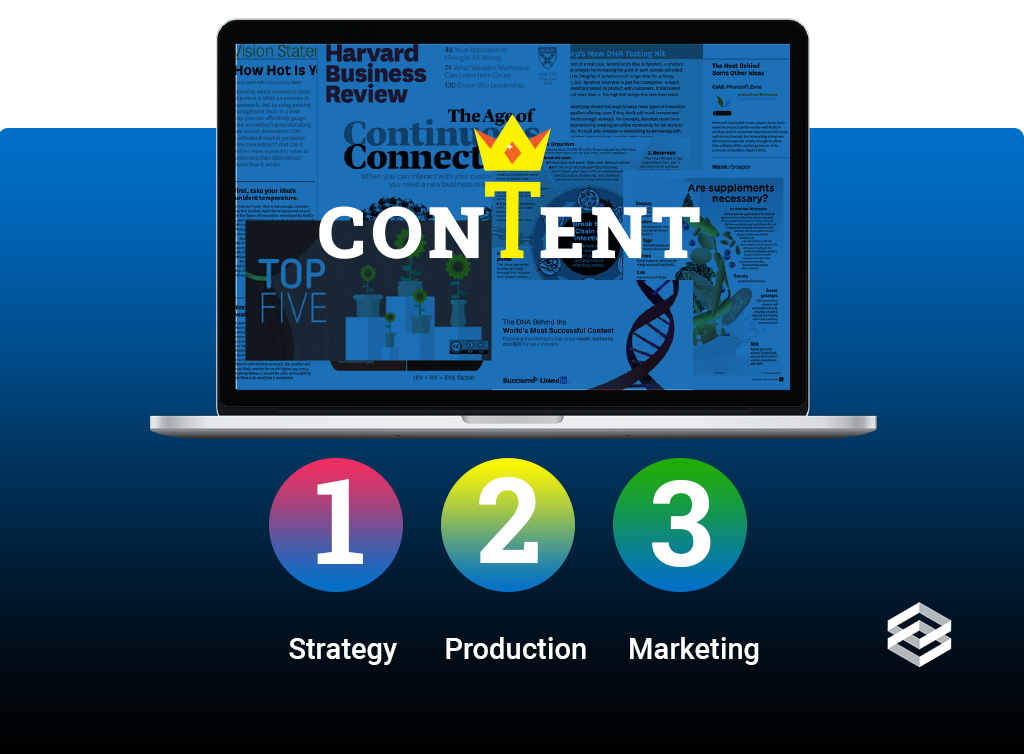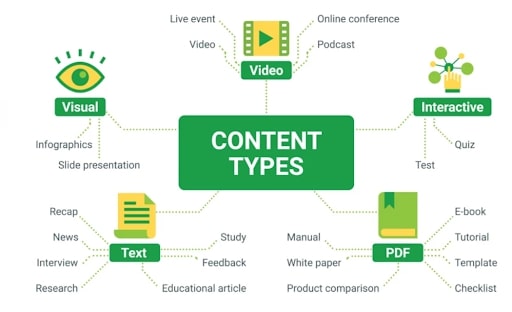Table of Contents
Content is by far the most important marketing tool and it never hurts to often revisit how you create, distribute, and govern content to promote your brand online. The more effective and in-depth your content strategy, the higher the likelihood you may reap better results in the form of increased revenue, improved brand image, and better customer experience.
In a digitally transformed environment where content is considered to be the king, it’s not a good idea to stay old-fashioned and let your competitors get a leg up on you. Your audience wants to be engaged and immersed in good content, but you can’t help much if you rely on obsolete recipes that never did the trick before.
Without further ado, let’s dive in to learn what those techniques are and how you can use them to develop a solid content marketing strategy for your own business in 2020 and beyond.
Know Your Audience And Give Them What They Want
You can’t make a killer strategy if you fail to make it audience-driven. And you also have to understand that making your content audience-driven doesn’t usually start with strategizing, it starts with understanding. In other words, before you spend any time on wrapping your head around what kind of content you should put together and distribute, you need to drill deeper into knowing who your audience is, what matters to them the most, and how your content is going to help them solve a specific problem they are confronted with.
Let’s break it down into simple steps.
The best place to start is in your own head. Use your objective judgment to figure out who your target audience is and what types of digital content they would enjoy to consume and share online. Would it be long-form text content or short and to the point how-to videos? Maybe they are too busy and a carefully curated industry news digest for the week would do the trick.
Knowing where your audience would like to hang around online is a useful way to develop a strategy for your content marketing. Let’s say your audience likes to spend more time on Pinterest and Twitter, your content now cannot be a one-size-fits-all material. Both the platforms being different distribution channels and having different set of requirements, you need to craft and deliver the message in a slightly different way. Tailoring your content strategy around these important (and usually overlooked) details could mean you’re rising above what’s mediocre and really shooting for a home run.
Make sure you take the time to research, analyze, and understand your target audience better to provide value that’s relevant in context and superior in value.
One of the tried and tested ways is to segment your audience based on their needs. Segmentation is crucial for one simple reason: some of your readers aren’t buyers, others potentially are. Simply put, your content can’t suit everyone because, most of the time, your prospects are at different phases of the buying cycle. For example, content designed to create awareness for new customers is wasted on repeat customers who already know what you’re up to. So you need to put some work into segmenting your audience and then craft a relevant strategy around each one of them.
Here’s essentially how you can go about the whole process.
Collect Demographic Data
Web analytics, social media analytics, and email subscriber analytics will give you the data you need on your audience. So the first step is to collect demographic data on your visitors, email subscribers, and social media followers. For a start, you may focus on a few (but strictly relevant) factors, such as:
- Age
- Gender
- Education
- Income
Going a step further, you may also want to gain some insight into their key interests. In Google Analytics, for example, you can go to Audience » Interests » Overview to see the market segments your web visitors fit into. Social media sites also offer similar data. For example, you may get demographic information on your Facebook fans via Facebook Page Insights.
Get Customer Feedback
One of the effective ways to learn about your target audience is to collect feedback from your existing customers. Doing so will help you gain valuable insights into:
- How your customers feel about the content you’re currently producing
- What their most urgent needs are and where the potential gap is
- How you can address their problems with your content
Getting the right customer feedback can help you understand your readers and subscribers’ priorities better. You will also have some handy data on where you can find your target audience. All of this will help you flesh out your buyer personas that, in turn, will lead to a more effective content strategy.
Buyer Personas
Collecting demographic information and customer feedback will provide a concrete basis for creating your buyer personas. Buyer personas, aka customer avatars, outline who your ideal readers and customers are so that you can make use of the information to create more targeted content.
There aren’t any hard and fast rules when it comes to crafting your customer avatars. Yet you need to understand that the best customer avatars don’t miss out on customers’ pain points, challenges, sources of information, and their behavioral motivators.
Once you have mapped out your buyer’s persona, you’ll have a better understanding of:
- The kind of content your audience will respond to
- How it will help them solve specific problems
- What will make them engage with it (and ultimately with your brand)
![]()
There’s a learning curve involved when you set out to create your buyer persona from scratch. To help you handle the process more effectively, here’s a nifty tool from Hubspot. It’s called Make My Persona.
Crafting your primary buyers’ persona should naturally lead to identifying their buying journey. Now your goal should be to help this buyer through each stage of the sales funnel: awareness, interest, consideration, and decision. And while there’s no magic number for the amount of content within the buyer’s journey, you can start by identifying three pieces of content: content for the awareness stage, content for the consideration stage, and content for the decision stage.
The “Jobs to Be Done” Framework
The “Jobs to Be Done” framework is an easy way to understand your customer’s needs and the reason they use your product. The idea is to place yourself in the prospect’s shoes and try to identify the jobs your customer is trying to get done. In other words, you’re trying to understand what it is your customers seek to address in given circumstances.
Here’s a quick tool you can try to effectively gain that insight:
When I ___ , that’s why I want ___ , so I can ___ .
- ‘When I___’ is the pain point of your potential customer.
- ‘That’s why I want ___’ is the solution your product/service can offer.
- ‘So I can ___’ is the prospect’s solution or the result he/she wants to achieve.
To simplify, here’s a basic example of how this tool can be used in the context of time-management:
When I work, I spend too much time completing all my tasks, that’s why I want a tool that improves my time management, so I can spend more time with my family.
Content and Stages of Buyer’s Journey
The buyer’s journey typically goes through three stages called the Awareness stage, the Consideration stage, and the Decision stage. Your content strategy needs to reflect where the reader stands and what content type will be more effective.
- Awareness Stage – These pieces are often centered around questions your audience may have at the top of the sales funnel. The purpose of content at this stage is to make the audience become more aware of their problem or needs; this can also take the form of content that tells your brand story, educates your audience, or entertains them in an immersive way.
- Consideration Stage – As they gradually advance towards the consideration stage, your prospects will naturally want to know more. Now you need to help them understand why they need assistance in overcoming the problem facing them. You can guide them through case studies, demonstrating how others have solved similar problems in the past. You can also discuss in detail the steps that may be necessary to approach a particular problem that your brand addresses.
- Decision Stage – These content pieces are designed to help the potential customers determine why you are the best choice of all the other options available. Case studies, client testimonials, and specific analysis of the work you have done in the past can come in quite handy at this stage as users tend to compare alternative options.
However, this isn’t where the cycle ends and this surely isn’t where you can sum up the content strategy. In fact, the two other stages that follow are even more important as they are concerned with retaining the customers and transforming them into brand ambassadors.
- Retention Stage – Customer acquisition is important but ensuring you get a larger share of their Life Time Value (LTV) is even more crucial. To retain customers, you’ll need to offer them something more than a boilerplate solution. Educate them on some of the best ways they can get the most out of your product or service. What common problems does it address and what new features should they be aware of? Anticipating the key questions your future customers will ask and addressing them preemptively can also keep prospects from falling into any sort of post-purchase dissonance.
- Advocacy Stage – These are pieces that highlight the parts of your brand that will transform customers into evangelists. This might include pieces that shed light on your corporate values, product philosophy, corporate social responsibility, or outstanding team members and the value they bring along.
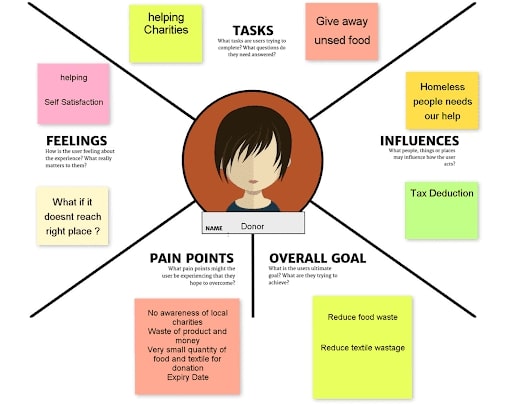
By now you might realize that understanding your customers isn’t as easy as it sounds. But, fortunately, there are tools you can utilize to help you through the process. The Empathy Map, described by Alexander Osterwalder and Yves Pigneur in their book Business Model Generation, is one such tool that can help you understand your target audience better.
The empathy map is based on a comprehensive approach that tells you what your customer says, thinks, does, and feels. By drilling deeper into how your customer looks at a specific problem, goes about fixing it, and feels after finding a solution, you may generate more insightful content that will have real value to be able to drive your marketing objectives.
Figure Out The Best Content Marketing Channels
Once you’ve decided on the types of content to fill your content calendar with, it’s time to choose specific content channels that will have the utmost relevance for your industry and business. In some cases, the channels you need to work with are going to be obvious. In other cases, they are not.
For example, if your focus is on creating blog posts, your content channel is going to be the blog itself. But if your focus is on generating content for social media, you’ll need to decide the platforms you’ll be marketing on — Instagram, Facebook, Twitter, others. By the same token, if you go with infographic or promo videos, you’ll need to decide the channels you’ll be sharing them on — could be social media, your own website, or third party platform.
As you work through this process, you’ll start getting a sense of where your audience is hanging out and where you already have some online presence. The key is to focus on what’s working and build on it rather than splatter your content everywhere without making it contextually relevant for a platform.
One of the best ways you can check what’s working and what’s only wasting your time is to navigate your Google Analytics. In Google Analytics, you can go to “Acquisition” » “Social” » “Overview” to see the main social networks where your content is shared. For example, in the screenshot below, most of the social activity takes place on Facebook and so it’s proving to be the most effective platform to factor in.
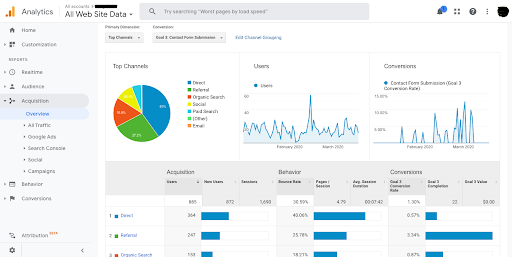
You can also use Buzzsumo to find similar data. Go to their Content Analysis tool and type your domain name into the onscreen search box. Press enter and you’ll see charts showing a great deal of useful data, including the following:
- Shares by network
- Shares by content type
- Shares by content length
- Top content in the past year
Set A Budget
Once you have decided on the types of content you’re creating and the channels you intend to utilize to market that content, it’s time to set a budget. You can ask yourself the following questions to help you determine a viable ballpark:
- Do you need to purchase any software or technology to create the content (such as Adobe Photoshop, a subscription to Canva, a camera to take high-quality photos and videos)?
- Do you need to hire content team members (such as artists, writers, editors, designers)?
- Do you need to pay for some ad/premium space?
- Do you need access to specific tools or resources to enhance or measure your specific type of content?
As you go about answering these questions, you may notice how your responses are providing a basis to help determine the projected budget. In most cases, it’s either higher or lower than what you may have initially expected.
Keeping the important rule in mind that the cost of producing a certain type of content must not outweigh its potential benefits, you may consider all or most of these content types.
It’s important that you match the content to the customer journey, ensuring that they have something good at every contact point! Use the following chart to help come up with a variety of relevant content at each stage of the buying cycle.
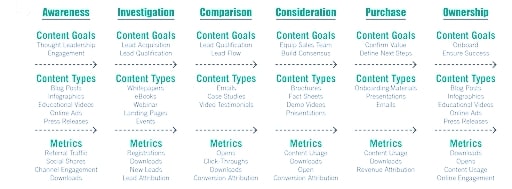
See How Your Content Is Working
Next, it’s time to evaluate the usefulness of the content you’re producing, distributing, and marketing. You’ll be looking at various metrics such as:
Knowing how your content performs will essentially help you do one of two things: either you’ll continue building on it or you’ll make some course correction to realign the strategy with end goals.
For instance, if you find out that users coming from a particular source or channel are bouncing off too quickly, it’s a strong sign that they are not getting what they expect from the content. It’s time to go back to the drawing board and figure out where the problem occurs and what changes in the strategy you can make to overcome that.
Identify Content Gaps
This is when you try to work out the less obvious but potential gaps your content strategy can exploit. These might include:
- Keywords related to your niche that you’re not targeting with your content
- Questions your target audience is asking that you’re not answering
- Content that’s starting to rank well but could be improved
Now choose the type of content you’ll create. To do this, start by thinking about your target audience and buyer personas. Answer the following questions about your target audience to help you narrow down the right types of content for them:
- What do they need from you?
- What challenges are they looking to overcome?
- Why do they need your product or service?
- How can you help them succeed?
Finally, take a look back at the various types of content we reviewed earlier to determine which types of content you’ll create that are not out of sync with the needs and expectations of your audience.
What are Your Competitors Offering That You’re Not?
Competitor analysis isn’t optional these days, it’s a necessity. Industry experts agree that competitor analysis is an integral part of search marketing success. The good news is, there are so many effective ways you can spy on your competitors to know exactly what they’re doing and how to outsmart them. Tools like SEMrush, Keyword Planner, SpyFu, and SimilarWeb are great resources you can utilize in the process.
What are Your Competitors Offering That You’re Not?
The story brand template essentially draws upon three things: your typical customer with a problem, the solution you provide, and the results the solution brings about. From mapping out who the customer is to understanding what their problems are to knowing what solution they need, the Storybrand Template provides an intelligent flow of actions that looks like this: A character with a problem meets a guide who understands their fear and gives them a plan that calls them to action.
Content Creation Framework Process
Creating content for the sake of content won’t do your business any good, nor will it be of any substantial value to your audience. So don’t create content just because you have to. If it’s not valuable to your audience, it’s a waste of everyone’s time. If you really want to make it worth your while, create content that’s educational and offers value to the audience.
Moreover, how readable and engaging your content sounds to human readers is just one part of the equation. The other important part is to make it accessible for the search engines. In other words, your content needs to be SEO-friendly if you want to care about the 35% of all website traffic that comes from organic searches (through search engines like Google, Bing, and Yahoo!).
A defined process will help keep your content creation efforts running like a well-oiled machine. We have already discussed many things you can utilize to set the wheels in motion; but if you really want to stand out, you need to have a process in place that’s more advanced and analytical (than just filling pages and churning out run-of-the-mill content). You need to be able to identify campaigns, set timelines, review, and edit before your content goes live.
When you are done working on the preliminary processes, it’s time to pick a title for your next piece and start working on it. Here are a few quick steps you can follow.
Research Your Content
The research part will help you find what’s already out there that’s making some buzz and how your new content can add value to it so that your audiences love it even more. That means doing a Google Search, Going over to platforms like Udemi and Amazon to see what types of content are making big hits, checking out the ones that relate to your specific situation, and seeing how you can build on them. There’s a term for this whole process that we know of as the “Skyscraper Technique.”
Original research also does great in most cases. So don’t leave it out of the equation if you have a potentially good topic to work on and you can collect the right data to materialize it.
Find Relevant Topics
To start, you will need to uncover the topics that attract your audience’s interest as they progress through the customer journey. There are many tools to help you handle this process more effectively, including SEMrush’s Topic Research, Niel Patel’s Ubersuggest, HubSpot’s Blog Idea Generator, Answer The Public, and Buzzsumo to name the most popular. These are great tools as they can give you some very useful ideas for topics you should care about. They also provide a repository of other relevant information including related questions, possible subtopics, headers, and audience insights that make your content ideation process all the more effective and easier.
On the more practical side, you may want to spend a quarter of an hour each week studying Udemy course modules or Amazon book reviews. Doing so will not only give you lots of ideas to write about but will also expand your analytical skills to gain a more thorough and deeper understanding of your industry and audience. On Udemy, for example, you can analyze the most successful courses or course modules and then extract ideas to include in your content. You want to implement this process because it’s going to enhance your content marketing strategy and make your content all the more valuable for those who will go through it.
Create the Pillar
Content marketers are constantly battling for attention in the online space. But with all the content being published online, search engines like Google are being forced to make better choices and showcase the content it thinks is helpful to the searchers. Creating content that has value for the human audience is not enough, you’ll also need to understand the art of optimizing it in a way it solves the search engines’ problem along the way.
Here’s what you need to do to solve this dichotomous puzzle of making your content valuable for both human readers and the search engine crawlers:
Create targeted clusters of relevant content where each cluster contains content pieces that cover a specific topic in depth.
Your targeted clusters need to be organized in a way they are linked with a centralized hub called a pillar page, aka content pillar or power page.
This pillar page on your website will essentially cover a specific topic in detail and will be strategically linked to a cluster of related content.
The way you structure your content matters. Think about a time you landed a blog page with the intention to read something, but no sooner did you read a line than you started to lose interest. The introduction failed to hook your attention; the sentences seem to ramble instead of getting to the point; you struggled to find a helpful next-step to continue your journey.
Sure enough, it wasn’t your fault. It was the failure of the author writing the post that he couldn’t pay close enough attention to the structure of the content.
All effective blog posts come with a blueprint. You might not easily see it, but it’s there and it’s meant to help the reader through the journey of making a well-informed and confident decision. The decision could be anything, from considering to buy a product or service, to making up one’s mind to do something in a certain way, to taking any other meaningful actions.
Make The Foundation Solid
Your website is your online destination. It’s where your potential customers interact with you to buy or inquire about your products and services. It also plays the key functions of your sales and marketing departments when it comes to generating leads, creating awareness, and building a brand image. When you look at your website this way, it’s going to change everything. You will now consider the optimization efforts, the marketing dollars, and the time you deployed on your site to make it SEO optimized as a long term investment (instead of a cost).
A major chunk of your content will live on your website for a long time, so you want to make it worth sticking around. Also, a lot of your promo content will go elsewhere, creating brand awareness and sending convertible traffic to your website. Make sure that your promo content doesn’t send traffic to a place on your site that’s not ready to receive it. For example, if your social content promotes your X product but your website doesn’t clearly showcase everything there’s to be showcased about that product, you’re inviting a visitor over only to bounce off in a few seconds. It’s foolish because it costs you money, customers, and perhaps, your brand reputation.
Create And Distribute The Content
Content marketing is bound to succeed when done effectively and over a sustained period of time. If you’re like the guy who creates one blog post a month and expects the magic to happen, the magic will never happen. You need to constantly feed your audience with great content so that you remain in their mind and purchase consideration. Use an editorial content calendar so that your team may stay on top of everything when it comes to producing content on a consistent basis.
The next key part of your content strategy is distribution and marketing. Remember that content is only as good as the readership it gets. In order words, creating good content (and in substantial quantity) is not enough, you also need to understand how to market and promote your content. The ultimate goal is to get as many people to read your content as possible and you may achieve it through the following key techniques:
Content promotion is an essential part of any content strategy. You may already have a good following that you can promote your content to. If not, you may consider paid promotion through social media and search ads as these methods have proven to be effective too.
To help review the effectiveness of different types of content marketing sources (including paid, owned, and earned media) that can be considered to distribute and promote your content, you can refer to this effective matrix designed by Smart Insights. This matrix will not only help distribute and promote your content but also generate site visits, leads, and sales — things that matter in the end.
Conclusion
Without a strategy, success or failure could only be a matter of luck. It’s true in the marketing space as it’s in every other aspect of life. Smart content marketers never leave things to chance and risk their time and scarce resources going to waste. If you also want to play it smart, you must learn how to build a solid content strategy that’s unique to your organization. I hope the techniques discussed in the material will help you build a more effective and profitable content marketing plan for your business in 2020 and beyond.
 +1-713-701-5823
+1-713-701-5823 +92-518-441-742
+92-518-441-742